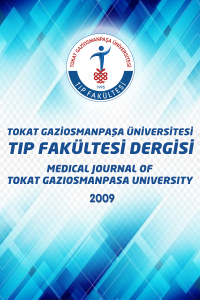Sinonazal Osteomların Bilgisayarlı Tomografi ile Değerlendirilmesi
Bilgisayarlı tomografi, paranazal sinüsler, sinonazalosteomlar
Evaluation of Sinonasal Osteomas with Computed Tomography
Computed tomography, paranasal sinuses, sinonasal osteomas,
___
- 1. Erdogan N, Demir U, Songu M, Ozenler NK, Uluç E, Dirim B. A prospectivestudy of paranasal sinüs osteomas in 1,889 cases: changing patterns of localization. Laryngoscope. 2009;119:2355–9.
- 2. Earwaker J. Paranasal sinus osteomas: a review of 46 cases. Skeletal Radiol. 1993;22:417–23.
- 3. Çelenk F, Baysal E, Karata ZA, Durucu C, Mumbuç S, Kanlıkama M. Paranasal sinüs osteomas. J Craniofac Surg. 2012;23(5):e433–7.
- 4. Gürsoy M, Karaca Erdoğan N, Dağ F, Başoğlu MS, Rezanko Atasever T. Giant osteoma with intracranial extension filling sinonasal cavity: a rarecase. Kulak Burun Bogaz Ihtis Derg. 2015;25(1):51–5.
- 5. Onal B, Kaymaz M, Araç M, Doğulu F. Frontal sinüs osteoma associated with pneumocephalus. Diagn Interv Radiol. 2006;12:174–6.
- 6. Boffano P, Roccia F, Campisi P, Gallesio C. Review of 43 osteomas of thecraniomaxillofacialregion. J Oral MaxillofacSurg. 2012;70(5):1093–5.
- 7. Atallah N, Jay MM. Osteomas of theparanasalsinuses. J LaryngolOtol. 1981;95:291–304.
- 8. Nielsen GP, Rosenberg AE. Update on bone formingtumors of theheadandneck. HeadNeckPathol. 2007;1:87–93.
- 9. Chahed H, Hachicha H, Bachraoui R, Marrakchi J, Mediouni A, Zainine R, Ben Amor M, Beltaief N, Besbes G. Paranasal sinüs osteomas: Diagnosis and treatment. Rev Stomatol Chir Maxillofac Chir Orale. 2016;117(5):306–310.
- 10. Ozdemir O, Calisaneller T, Kiyici H, et al. Sphenoid sinüs osteoma: report of a case. Turk Neurosurg. 2006;16:85–88.
- 11. Virk RS, Sawhney S. Osteoma of the Middle Turbinate Presenting with Frontal Lobe Abscess and Seizure. J Clin Diagn Res. 2017;11(5):MD01–MD03.
- 12. Sahemey R, Warfield AT, Ahmed S. Bilateral inferior turbinate osteoma. J Surg Case Rep. 2016:17;2016(8). pii: rjw135.
- 13. Daneshi A, Jalessi M, Heshmatzade-Behzadi A. Middle turbinate osteoma. Clin Exp Otorhinolaryngol. 2010;3(4):226–8.
- 14. Koivunen P, Löppönen H, Fors AP, Jokinen K. Thegrowth rate of osteomas of theparanasalsinuses. ClinOtolaryngolAlliedSci. 1997;22:111–4.
- 15. Summers LE, Mascott CR, Tompkins JR, Richardson DE. Frontal sinüs osteoma associated with cerebral abscess formation: a casereport. SurgNeurol. 2001;55:235–9.
- 16. Koyuncu M, Belet U, Seşen T, Tanyeri Y, Simşek M. Hugeosteoma of the frontoethmoidal sinüs with secondary brain abscess. Auris Nasus Larynx. 2000;27(3):285–7.
- 17. Jurlina M, Janjanin S, Melada A, Prstacić R, Veselić AS. Large intracranial intradural mucocele as a complication of frontal sinüs osteoma. J Craniofac Surg. 2010;21(4):1126–9.
- 18. Dolan KD. Paranasal sinüs radiology, part 1B: the frontal sinuses. Head Neck Surg. 1982;4:385–400.
- ISSN: 1309-3320
- Başlangıç: 2009
- Yayıncı: Tokat Gaziosmanpaşa Üniversitesi
Orhan BALTA, Murat AŞÇI, Bora BOSTAN, Mete GEDİKBAŞ
Diz Revizyon Cerrahisi Sonrsı Patellar Tendon Rüptürünün Aşil Tendon Allogrefti ile Rekonstrüksiyonu
Orhan BALTA, Murat AŞÇI, Bora BOSTAN, Cihan UÇAR
Fasial Anomali ve Siklopinin Eşlik Ettiği Holoprozensefali: Olgu Sunumu
Engin KORKMAZER, Tayfur ÇİFT, Muzaffer TEMÜR, Emin ÜSTÜNYURT, Bülent ÇAKMAK, Gülçin SERPİM, Merve SEYFİ
Sinonazal Osteomların Bilgisayarlı Tomografi ile Değerlendirilmesi
Enes ESER, Murat AŞÇI, Orhan BALTA, Bora BOSTAN, Erkal BİLGİÇ, Taner GÜNEŞ
